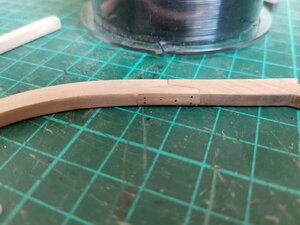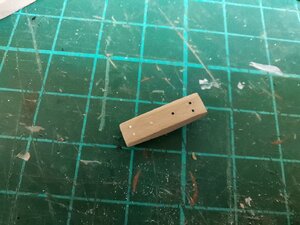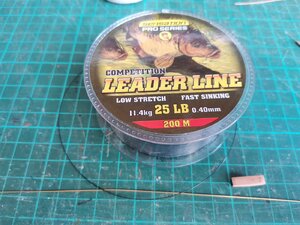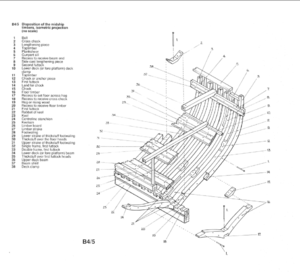-

Win a Free Custom Engraved Brass Coin!!!
As a way to introduce our brass coins to the community, we will raffle off a free coin during the month of August. Follow link ABOVE for instructions for entering.
-

PRE-ORDER SHIPS IN SCALE TODAY!
The beloved Ships in Scale Magazine is back and charting a new course for 2026!
Discover new skills, new techniques, and new inspirations in every issue.
NOTE THAT OUR FIRST ISSUE WILL BE JAN/FEB 2026
You are using an out of date browser. It may not display this or other websites correctly.
You should upgrade or use an alternative browser.
You should upgrade or use an alternative browser.
Thank you Paul, but I realy hoped to find you "translation" of the Instructions here 
Also, my copy of the instructions are becoming paler and paler to the end ... I was able to scan and enhance most of the pictures, but I can't see any of the pictures with the metal parts on in...
I have asked Trident for an electronic Instruction, but haven't heared from them yet.
Maybe someone could scan the 3 pages (46-48) and post them please?
Also, my copy of the instructions are becoming paler and paler to the end ... I was able to scan and enhance most of the pictures, but I can't see any of the pictures with the metal parts on in...
I have asked Trident for an electronic Instruction, but haven't heared from them yet.
Maybe someone could scan the 3 pages (46-48) and post them please?
- Joined
- Sep 9, 2017
- Messages
- 135
- Points
- 133

Thanks Paul.. Great info...and thanks JohnA..I am still of the opinion that I will "clean up" at a later stage of construction.
One little inaccurate "grind "could render the entire rib unserviceable.(Is my lack of self confidence and top of the range tools showing itself?)
Also I have noticed that the variance and flexablity of the templates could cause an issue.
Some of the margins are scarceley a gnats dick in size.
I do appreciate the input from you guys.
One little inaccurate "grind "could render the entire rib unserviceable.(Is my lack of self confidence and top of the range tools showing itself?)
Also I have noticed that the variance and flexablity of the templates could cause an issue.
Some of the margins are scarceley a gnats dick in size.
I do appreciate the input from you guys.
“The Guide says there is an art to flying", said Ford, "or rather a knack. The knack lies in learning how to throw yourself at the ground and miss.”
― Douglas Adams, Life, the Universe and Everything
― Douglas Adams, Life, the Universe and Everything
I used Libre Office. free version of office on a mac . Just tried no issues.
I checked the translated version from Paul, got the same message on opening ... but everything was fine with the file after clicking "ok" !
I wonder about a few things related to the grinding /fairing of frames. I'm not sure if it is the right place to ask but it came to my mind when looking at the pictures in the 'frame template guide'.
Are any of you guys planning to use brass bolts/nails in the frames? I guess it would be very hard to control a drill bit if the angle against the surface is not somewhere around perpendicular, so for the bolts/nails in the chucks, should the holes be drilled before the grinding?
Would you also stick in the brass nails before grinding? And if so, how to deal with blackening?
I also came to wonder if bolts or trunnels was used to fix the chucks? I assume bolts was used through the double frames but I wonder if bolts was also used for chucks / anchor pieces with holes not perpendicular to the surface and moreover against the outer planking?
Are any of you guys planning to use brass bolts/nails in the frames? I guess it would be very hard to control a drill bit if the angle against the surface is not somewhere around perpendicular, so for the bolts/nails in the chucks, should the holes be drilled before the grinding?
Would you also stick in the brass nails before grinding? And if so, how to deal with blackening?
I also came to wonder if bolts or trunnels was used to fix the chucks? I assume bolts was used through the double frames but I wonder if bolts was also used for chucks / anchor pieces with holes not perpendicular to the surface and moreover against the outer planking?
These files contain all the images from SAM Chan & trident in the the new kit logs. There is over 500 images for ref.
I know that there is some somewhere for the barrels & cabins in the SOS present portion, hoever i oculd not find them. If you do pls add. I figured it was easier to see all the images locally on your PC rather than to hunt logs. They are in date order.
Admins : If I have broken any rules please delete them and I apologize.
No images from member logs are included.
I know that there is some somewhere for the barrels & cabins in the SOS present portion, hoever i oculd not find them. If you do pls add. I figured it was easier to see all the images locally on your PC rather than to hunt logs. They are in date order.
Admins : If I have broken any rules please delete them and I apologize.
No images from member logs are included.
Attachments
I wonder about a few things related to the grinding /fairing of frames. I'm not sure if it is the right place to ask but it came to my mind when looking at the pictures in the 'frame template guide'.
Are any of you guys planning to use brass bolts/nails in the frames? I guess it would be very hard to control a drill bit if the angle against the surface is not somewhere around perpendicular, so for the bolts/nails in the chucks, should the holes be drilled before the grinding?
Would you also stick in the brass nails before grinding? And if so, how to deal with blackening?
I also came to wonder if bolts or trunnels was used to fix the chucks? I assume bolts was used through the double frames but I wonder if bolts was also used for chucks / anchor pieces with holes not perpendicular to the surface and moreover against the outer planking?
Good question PoulD, I've been pondering this question for the past few weeks as well. From the Chinese guys build logs it seems that they have gone with brass 'bolts' without blackening them. I'm experimenting with black monofilament fishing line, let me know what you think?



Hello Poul,I wonder about a few things related to the grinding /fairing of frames. I'm not sure if it is the right place to ask but it came to my mind when looking at the pictures in the 'frame template guide'.
Are any of you guys planning to use brass bolts/nails in the frames? I guess it would be very hard to control a drill bit if the angle against the surface is not somewhere around perpendicular, so for the bolts/nails in the chucks, should the holes be drilled before the grinding?
Would you also stick in the brass nails before grinding? And if so, how to deal with blackening?
I also came to wonder if bolts or trunnels was used to fix the chucks? I assume bolts was used through the double frames but I wonder if bolts was also used for chucks / anchor pieces with holes not perpendicular to the surface and moreover against the outer planking?
A very interesting question. Here below is from Alert's book by P.Goodwing. The picture below specifically show the various fastenings and their names.

I am also thinking using bolt immitation, but with scale what should be the max diameter of those? I think 3mm ot 3,5 (max). I might use copper wire as when aged, it will be naturally blackened (darkened) or brass wire. But... bolted all of the frames might be too much for the overal appirance. Hmm... I am not sure what to do.
@Jolley Roger: Many thanks. Judging from the pictures the fishing line looks okay 
@Jimsky: Many thanks. To me it is not 100% clear from the drawing if it is bolts in the chucks (except for the middle one in the cross chuck that goes into the keel). As for bolt head size have no knowledge whatsoever but I would guess 0.4 mm might not be too bad? (corresponding to Ø 19.2 mm at 1:48)
@Jimsky: Many thanks. To me it is not 100% clear from the drawing if it is bolts in the chucks (except for the middle one in the cross chuck that goes into the keel). As for bolt head size have no knowledge whatsoever but I would guess 0.4 mm might not be too bad? (corresponding to Ø 19.2 mm at 1:48)
Hello Paul, hello Poul,
I think that 0.4mm is too thick.
I believe that the Alert book mentions dimensions next to the schematic drawings of the bolting, but I could be wrong. I will have another look. Maybe it works with 0,25mm? but even this "bolt" would still be too strong in my opinion, or what do you think?
Maybe a bolting is really nonsense or you really use copper wire. But then the drillings are in the range of 0,1 mm...puhhhh
I think that 0.4mm is too thick.
I believe that the Alert book mentions dimensions next to the schematic drawings of the bolting, but I could be wrong. I will have another look. Maybe it works with 0,25mm? but even this "bolt" would still be too strong in my opinion, or what do you think?
Maybe a bolting is really nonsense or you really use copper wire. But then the drillings are in the range of 0,1 mm...puhhhh
Just remember it is the bolt head that will be seen not the shaft.Hello Paul, hello Poul,
I think that 0.4mm is too thick.
I believe that the Alert book mentions dimensions next to the schematic drawings of the bolting, but I could be wrong. I will have another look. Maybe it works with 0,25mm? but even this "bolt" would still be too strong in my opinion, or what do you think?
Maybe a bolting is really nonsense or you really use copper wire. But then the drillings are in the range of 0,1 mm...puhhhh
Your fishing line bolts are looking fine - and I think that the size is also ok, as John mentioned already the bolt heads are visible.
black or grey bolts are I think technically correct, nevertheless the bolts in brass are used very often (especially by modelers in Europe - it is here often a question of taste
black or grey bolts are I think technically correct, nevertheless the bolts in brass are used very often (especially by modelers in Europe - it is here often a question of taste
- Joined
- Sep 9, 2017
- Messages
- 135
- Points
- 133

Paul, Thanks for that omnibus of images..it certainly makes life easier.
There needs to be a conversation re "to bolt or not to bolt" and what materials are best. I like the fishing line concept so far. I purchased a couple of packs of "track pins" used by the model rail chaps.. They may be a tiny bit oversize for the general fasteners, but could serve as some of the more significant fasteners i.e. keelson/keel bolts. I'll run a couple of trials and let you know. Cheers, Danielw
There needs to be a conversation re "to bolt or not to bolt" and what materials are best. I like the fishing line concept so far. I purchased a couple of packs of "track pins" used by the model rail chaps.. They may be a tiny bit oversize for the general fasteners, but could serve as some of the more significant fasteners i.e. keelson/keel bolts. I'll run a couple of trials and let you know. Cheers, Danielw
I don't know which material such track pins are made of but are you aware that some metals (e.g. iron) may over some years react with tannins in the wood, causing the wood around the pin to be discolouredPaul, Thanks for that omnibus of images..it certainly makes life easier.
There needs to be a conversation re "to bolt or not to bolt" and what materials are best. I like the fishing line concept so far. I purchased a couple of packs of "track pins" used by the model rail chaps.. They may be a tiny bit oversize for the general fasteners, but could serve as some of the more significant fasteners i.e. keelson/keel bolts. I'll run a couple of trials and let you know. Cheers, Danielw
H Daniel agree, this is the place to put mods & general image posts. Be warned that 7 to 13 . have significant internal tapering to align with other frames( especially where the pins would go,) so it may be difficult to represent. Perhaps pusedo could be good on these actual fames. Fames 14 onward is only minor and edging. Sanding after being put in place is difficult and would be more so once pinned. Post pinning will also be difficult to drill & implement here. The frames are quite sturdy in the berth but it would be risky. A marking template with holes would need to be used.





